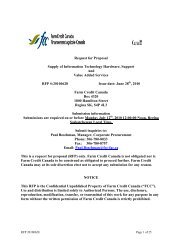Read the full version (PDF) - FCC-FAC
Read the full version (PDF) - FCC-FAC
Read the full version (PDF) - FCC-FAC
You also want an ePaper? Increase the reach of your titles
YUMPU automatically turns print PDFs into web optimized ePapers that Google loves.
14 | AgriSuccess Journal Planning to succeed<br />
Are you a leader or a manager?<br />
It’s a cliché, but change is with us all <strong>the</strong> time.<br />
In just <strong>the</strong> last 20 years, we have adopted<br />
and abandoned <strong>the</strong> fax machine, we have<br />
blue-too<strong>the</strong>d cell phones permanently in our<br />
ears and we now check e-mail on our hand-helds<br />
while <strong>the</strong> GPS steers <strong>the</strong> tractor. There’s no more<br />
“hog cycle,” just a continual round of mini-cycles,<br />
some far more dramatic than o<strong>the</strong>rs.<br />
You need to<br />
lead first and<br />
manage second.<br />
How do we cope with<br />
all this change from a<br />
professional point of view?<br />
There are two essential skills<br />
to be considered: leadership<br />
and management.<br />
Leading is about coping with change; managing<br />
is about coping with complexity. Take fuel prices,<br />
for example: leaders are looking at alternative<br />
fuels to reduce dependency and costs, even if<br />
it means producing <strong>the</strong>m on <strong>the</strong> farm (and<br />
that’s not always successful). Managers figure<br />
out how to deal with <strong>the</strong> higher costs with new<br />
equipment, different technology and techniques,<br />
or even different suppliers.<br />
So, leading is about deciding where to go and<br />
managing is about how you’re going to get <strong>the</strong>re.<br />
With higher commodity prices, a lot of producers<br />
Business strategies that work<br />
B Y H U G H M AY N A R D<br />
are probably re-thinking <strong>the</strong> road <strong>the</strong>y’re going to<br />
take: pay down debt, invest to be more efficient or<br />
expand, stay in <strong>the</strong> business – or even get out while<br />
<strong>the</strong> getting’s good. Managers find <strong>the</strong> best way to<br />
do it once a decision has been made.<br />
The key is to get <strong>the</strong> sequence right. You need<br />
to lead first and manage second. Successful leaders<br />
have a plan that maps out where <strong>the</strong>y’d like <strong>the</strong> farm<br />
to be – what <strong>the</strong>y’d like it to develop into – five,<br />
10, 20 years down <strong>the</strong> road. The plan doesn’t have<br />
to be complicated. It can be as simple as having a<br />
budget that paints a picture of anticipated revenues<br />
and expenses. The fact that reality doesn’t always<br />
follow <strong>the</strong> budget doesn’t mean <strong>the</strong> plan’s a flop.<br />
Instead, it’s a guidepost that measures success<br />
and failure, so management can play <strong>the</strong> role<br />
of “fixer” when <strong>the</strong> time comes.<br />
The bigger <strong>the</strong> plan, <strong>the</strong> more complex its application<br />
and <strong>the</strong> more skill it will take. Despite this additional<br />
complexity (and <strong>the</strong>refore <strong>the</strong> greater need for<br />
management), leadership still comes first. When<br />
things go well, leadership kicks into gear to look<br />
at what <strong>the</strong> next steps will be. When things don’t<br />
go well, leadership makes <strong>the</strong> tough decision on<br />
when to cut losses or change direction.<br />
Change will always be with us. What kind of plan<br />
do you have in your leadership wallet? ❖
















